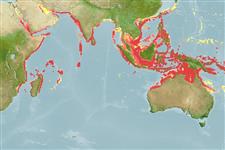>
Eupercaria/misc (Various families in series Eupercaria) >
Lethrinidae (Emperors or scavengers) > Lethrininae
Etymology: Lethrinus: Greek, lethrinia, a fish pertaining to genus Pagellus.
More on author: Valenciennes.
Environment: milieu / climate zone / depth range / distribution range
Ecologie
marien rifbewoner; standvastig; diepte 10 - 200 m (Ref. 2295). Tropical; 32°N - 23°S, 32°E - 160°E
Indo-West Pacific: widespread, including the Red Sea, Arabian (Persian) Gulf, East Africa to Sri Lanka, to the Ryukyu Islands and Papua New Guinea. Also recorded from Micronesia (Ref. 3807) and French Polynesia (Ref. 4517) but these are probably misidentifications of Lethrinus olivaceus.
Lengte bij maturiteit / Grootte / Gewicht / Leeftijd
Maturity: Lm 29.1 range ? - ? cm
Max length : 80.0 cm TL mannelijk / geslacht onbekend; (Ref. 48635); common length : 40.0 cm TL mannelijk / geslacht onbekend; (Ref. 2295); max. gepubliceerd gewicht: 4.9 kg (Ref. 40637)
Dorsale stekels (totaal) : 10; Dorsale zachte stralen (totaal) : 9; Anale stekels: 3; Anale zachte stralen: 8. The snout is moderately long, its dorsal profile slightly concave. Body color is bluish gray or brown often with scattered irregular dark blotches on sides; sometimes three dark streaks radiate forward from the eye. The fins are pale or orangish.
Found over sandy areas near coral reefs (Ref. 30573). Feeds on fish, crustaceans, cephalopods, and polychaetes. Swims in small schools sometimes together with L. olivaceous. Utilized as a food fish. Maximum depth reported taken from Ref. 9773.
Levenscyclus en paargedrag
Maturiteit | Voortplanting | Paaien | Eieren | Fecunditeit | Larven
Carpenter, K.E. and G.R. Allen, 1989. FAO Species Catalogue. Vol. 9. Emperor fishes and large-eye breams of the world (family Lethrinidae). An annotated and illustrated catalogue of lethrinid species known to date. FAO Fish. Synop. 125(9):118 p. Rome: FAO. (Ref. 2295)
Status op de Rode Lijst van het IUCN (Ref. 130435: Version 2024-2)
Gevaar voor de mens
Reports of ciguatera poisoning (Ref. 31637)
Gebruik door de mens
Visserij: commercieel; sportvis: ja
Tools
Speciale rapporten
Download XML
Internetbronnen
Estimates based on models
Preferred temperature (Ref.
123201): 24.7 - 29.1, mean 28.1 °C (based on 1954 cells).
Fylogenetische diversiteitsindex (Ref.
82804): PD
50 = 0.5000 [Uniqueness, from 0.5 = low to 2.0 = high].
Bayesian length-weight: a=0.01175 (0.00760 - 0.01816), b=2.97 (2.85 - 3.09), in cm total length, based on LWR estimates for this species & Genus-body shape (Ref.
93245).
Trofisch niveau (Ref.
69278): 3.8 ±0.51 se; based on food items.
Generation time: 5.5 ( na - na) years. Estimated as median ln(3)/K based on 2
growth studies.
Weerstandsvermogen (Ref.
120179): Gemiddeld, minimale populatieverdubbelingstijd 1,4-4,4 jaar (K=0.20).
Prior r = 0.57, 95% CL = 0.37 - 0.85, Based on 1 data-limited stock assessment.
Fishing Vulnerability (Ref.
59153): Moderate to high vulnerability (46 of 100).
Climate Vulnerability (Ref.
125649): Very high vulnerability (89 of 100).
Nutrients (Ref.
124155): Calcium = 30.8 [21.6, 41.5] mg/100g; Iron = 0.726 [0.499, 0.997] mg/100g; Protein = 20.3 [17.7, 22.4] %; Omega3 = 0.124 [0.092, 0.165] g/100g; Selenium = 51 [27, 76] μg/100g; VitaminA = 25.1 [5.6, 129.2] μg/100g; Zinc = 1.81 [1.40, 2.24] mg/100g (wet weight); based on
nutrient studies.
